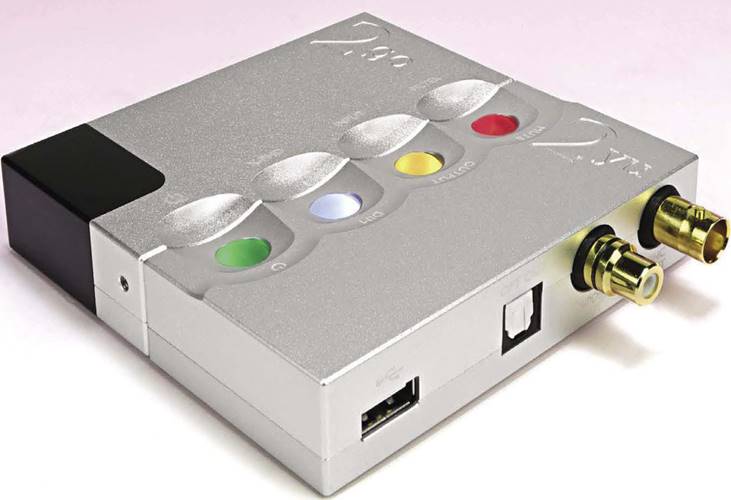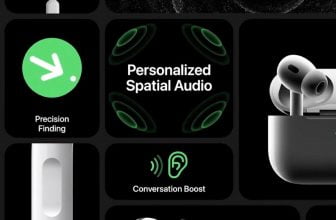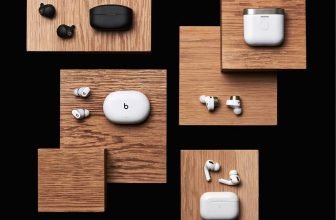CHORD ELECTRONICS 2YU Review: up TO YU
Chord Electronics 2yu bridge for their 2go streamer, reviewed by Noel Keywood. Read our CHORD ELECTRONICS 2YU Review.
Continuing Chord Electronic’s use of short, self-explanatory names to suggest a product’s function, they recently launched 2yu – a bridge unit between the 2go streamer and outside world. In original form 2go was purposed to plug into their Hugo DAC, as we explained in our 2go review. But what if you want to plug into someone else’s DAC or a digital amplifier perhaps? Then you need 2yu – it’s as simple as that. It’s an interface that allows the 2go streamer to speak by digital to other products, not just Hugo.
For this review of 2yu with 2go we also received a Qutest DAC, reviewed in the Nov18 issue, so here’s a look at all three, but to pick out the practical nature of 2go+2yu I plugged the combo into our Creek Voyage i20 amplifier, since this is how it may be used in practice.
2yu is a small package measuring 100mm long, 50mm wide and 22mm high. It comes in a strong but well finished machined alloy case with BNC, RCA phono socket and TOSLINK optical outputs, all handling S/PDIF.There’s also a USB A output. Cables are supplied for each output: BNC- BNC, optical TOSLINK-TOSLINK, USB A to USB B.
Also supplied is a plastic bag with small bits: two locating pins, two tiny grub screws and a hex key to tighten them. The pins must be screwed into 2yu to strengthen its mechanical connection with 2go, that otherwise relies on two small microUSB electrical sockets. It’s a fiddle: one pillar needed persuasion with pliers to run up its thread and the grub screws are so small they must not be allowed to reach the floor or will disappear down a gap between the boards. Technique here – as with pickup cartridge fixing – is to carry out process on a soft, lightly crumpled cloth to catch and retain s screw trying to make an escape. But there was more fun to be had…
2yu has no app or power supply, It is powered from 2go. Once bolted on it offers four illuminated button options. These are power on/off, a button-light dimmer, output select (USB/S- PDIF) and Mute.There is no remote control of these functions, but mute happens when pausing or stopping Play in the app of course. 2yu only remains powered and working whilst 2go is mains powered, falling silent when it is removed even though 2go has internal batteries.
Setting up 2go was as peculiar and awkward as I found in my original review, but with the benefit of experience easier and quicker to negotiate this time around.To set up, Chord Electronic’s GoFigure app must be downloaded. Afterward, any player app can be used, mconnect being recommended and the one I used.
First hang-up: my old GoFigure app did not work but a new download did (it has been updated).Then I was told the ethernet connection I’d established for measurement purposes did not need GoFigure. Also – and unusually – ethernet does not take precedence and auto-connect as it does in most products. Instead, a small Config button must be pressed to initiate ethernet recognition, whereupon my BT SmartHub 2 router positively identified it as Chord 2go – a good start. Many products still come up as ‘unknown’. And, as a postscript, having been through this process ethernet was then seen by GoFigure and did take precedence!
“2go+2yu played it differently: there was the snappy sense of insight and definition Chord Electronics major on”
This done, mconnect and 8player Pro saw it, from where I could select online sources like Tidal or Qobuz, play music files on the iPhone or on a microSD card in 2go, since it has two 2TB card slots – massive capacity. Audirvana+ software player on a network-connected MacMini saw ‘2Go’ as a UPnP ‘active audio device’ able to play up to a declared 192kHz sample rate PCM and even DSD64 up to 512, but the 2yu User Manual states PCM at 384kHz sample rate and DSD64 data rate as upper limits. DSD64 played successfully but the USB A output and lead must be used here, since DoP is being sent to the DAC (and the DAC must accept DoP); there’s silence from the S/PDIF outputs.
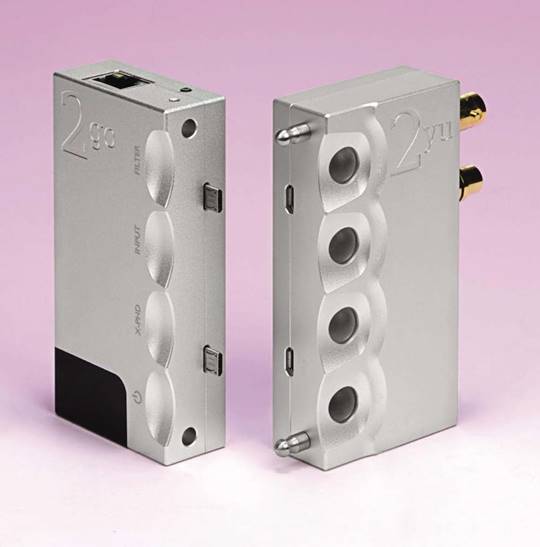
2yu (at right) plugs into 2go electrically through microUSB plugs and mechanically through spigots, locked into place by tiny grub screws.
This is a push-play system from Mac, where music is played out of the computer. With the PC switched on I could also pullplay from its music files using mconnect, both computers acting as hi-res UPnP servers.
The Mac’s Sound control panel made Airplay available also, but this is CD quality only. Similarly the iPhone offered Airplay as an option, but I defaulted to mconnect sending phone files to 2go as a UPnP player.This gave a full 124dB Dynamic Range measurement showed, as did play from microSD card, MacMini and the PC. It all worked fine with ethernet but some stuttering occurred with wi-fi which was a range issue. I suspect optional aerials would help.
2go’s wi-fi connection is 2.4GHz only, so GoFigure would not see my wi-fi (5GHz) until I switched 2.4GHz on. Then it needed password entry rather than creating a local set-up channel that avoids this. In London I have been forced to use a very long password and 5GHz to stop my wi-fi being used for dubious purposes, making 2go awkward to set up on wi-fi, but it worked OK – sort of. Mconnect initially would not then see 2go as a UPnP device, playing via Airplay which gave just 100dB Dynamic Range, but after a shut down and re-set it did. Oh what fun!
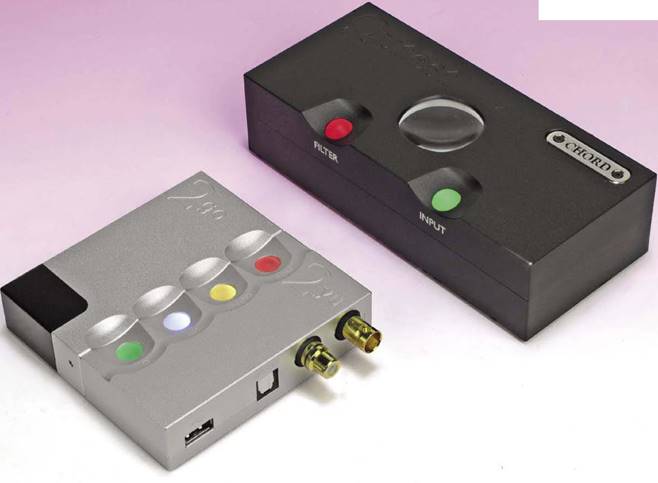
2yu has four digital outputs, to feed an external DAC or digital amplifier. At left USB, then S/PDIF through optical TOSLINK, RCA phono socket or BNC socket. We used it with Chord Electronics’ Qutest DAC, seen behind.
Bluetooth can be used as a control channel to 2go it seems, the GoFigure player being able to play from microSD card for example (after building a database). But I was unable to send music files to 2go from my iPhone with or without the dedicated Airplane/Bluetooth mode. There may be a way of doing this but I could not find it.The GoFigure app saw 2yu connected to 2go so all was well here.
So 2yu does deliver super high resolution music from 2go including DSD (as DoP), providing 2go is set appropriately. At worst Airplay steps in to deliver CD quality.The need for two apps and the confusions that arise from arrays of menus, options and transmission methods are challenging, but this relates to 2go rather than 2yu. Once up and running mconnect worked well.
Within a system, rather than on the test bench, 2yu’s purpose became clearer. I used the supplied optical cable to connect into our Creek Voyage
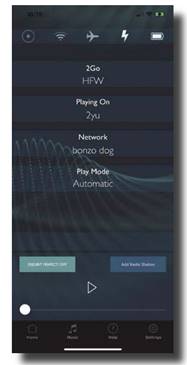
The basic status screen of the GoFigure app, showing Airplane/Bluetooth mode at top, Radio stations and a player at bottom, with transport control and Music file selection. This overlaps with mconnect app in function. i20 amplifier, turning this linked pair into a small, high resolution player able to play from a music library stored on two microSD cards or from a computer – Mac or PC.As well as from commercial streaming services too:Apple, Amazon et al.
2yu turns 2go into a standalone streamer and player in effect and it all worked well. Because there is no on-board screen or power supply 2go and 2yu together become a tiny, lightweight but solidly built digital source that, on our rack, sat beside the Creek on the same shelf. Small size and robust build are key strengths here.There is, however, a small 5V switch-mode power supply to feed them.
SOUND QUALITY
Since this is a review of 2yu there’s not so much to say about sound because it is just a bridge, having no direct influence on sound quality – in simple outline at least. But I still found 2go+2yu delivered a crisp, fast sound from microSD card through the Creek’s internal AKM DAC that curiously was more Chord Electronics sound than that I know from AKM or Creek.
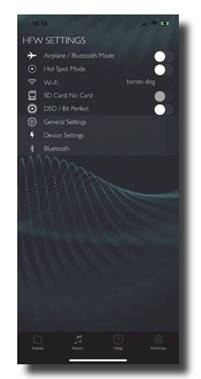
The GoFigure app’s Settings menu, with Airplane and wi-fi Hot Spot mode, SD card recognition and DSD/bit perfect option too.
AKM DACs are even fuller and warmer sounding than those from ESS, very much in keeping with their “Velvet Sound” moniker. Creek amplifiers too are far from the bright side, having a lovely analogue ease and depth to them. Yet in this environment 2go+2yu played it differently: there was the snappy sense of insight and definition Chord Electronics major on, rather than warmth. Benjamin Grosvenor’s fingers hit the piano keys with a sense of precision, playing Chopin’s Nocturne No 5, Opus 15 No2 (24/96).The delicacy of his touch was made clear as well as his fluid timing – it was more an insightful than full bodied sound.
Much the same with Rock where, for example, I got to hear right into the fine inflections of Marta Gomez singing Lucia (24/96) from an image hard chiselled rather than soft edged. Deeply insightful, not fluffy or warm. Chord Electronics products see further in than most but they don’t romanticise.
“hard chiselled rather than soft edged. Deeply insightful, not fluffy or warm”
I ran the Qutest DAC separately, plugging in our Oppo BDP-205D as a CD transport, connected digitally via the optical cable supplied. Qutest then fed the Creek i20’s analogue inputs that drove in turn our Martin Logan ESL-X hybrid electrostatic loudspeakers.With its unique DAC and massive dynamic range Qutest delivers the Chord Electronics sound in spades, with crisp, chiselled images placed on a big, quiet sound stage. It shouts “I’m good”, being more upfront than ESS and AKM DACs, making it seem vivid and deeply insightful in comparison. It’s a ‘stand up and take no prisoners’ delivery that demands good source material and – dare I say it – DSD worked better than PCM. In fact I got quite hooked on listening to DSD through the Qutest: the two seem well matched. Such musings apart though, Qutest remains a startling DAC of vast ability my re-encounter with it reminded me.
CONCLUSION
The small 2yu bridge is a neat little addition to Chord Electronic’s 2go, the two forming a small streamer of very wide ability, able to read music from commercial music servers, internal microSD cards, mobile ‘phone, Mac and PC – including DSD64 files. 2go’s need for two apps that share music finding and playing responsibility remains a difficulty that needs solving for ease of use.And whilst all was well with ethernet connection, wi-fi was temperamental compared to that of other streamers, likely due to lack of dedicated aerials, so best used with ethernet.
Great technical ability and sound quality though, as always with products from Chord Electronics, so definitely worth hearing. I very much enjoyed it.
MEASURED PERFORMANCE
Frequency response of the Qutest reached 46kHz (-1dB) before rolling off to the upper theoretical limit of 96kHz, our analysis shows, with 24/192 PCM data and the ‘Incisive Neutral’ (white) filter. The ‘Warm’ (orange) filter was similar. The ‘Incisive Neutral HF roll-off’ (green) and ‘Warm HF roll-off’ (red) both rolled off treble to -1dB at 20kHz so will sound warm – with both hi-res and CD.
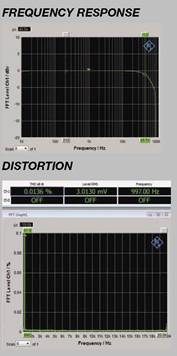
Frequency response 4Hz- 46kHz
Distortion (24bit, -60dB) 0.014%
Separation 101dB
Dynamic range 124dB
Noise -122dB
Output 1V / 2V / 3V
The BNC electrical inputs worked at 192kHz sample rate, the optical had a 176.4kHz upper limit with the cable supplied, becoming intermittent at 192kHz where nowadays most products are not.
Distortion was extremely low, measuring just 0.013% (-60dB, 24bit), our analysis showing just noise. This resulted in a class leading EIAJ dynamic range value of 124dB. Qutest maintains a massive Dynamic Range advantage over most else.
Output measured 3V maximum (there are 1V and 2V options). Results are best at 3V since this raises signal above output amplifier noise; as before Qutest was measured at this setting.
The Qutest sets measurement standards. The only problem is an optical input with a 176.4kHz sample rate limit; this may be a TOSLINK plug fitting issue. Chord Electronics say it does work at 192kHz.
CHORD ELECTRONICS 2YU
OUTSTANDING – amongst the best.
VERDICT
Chord Electronics
+44 (0)1622 721444
www.chordelectronics.com
